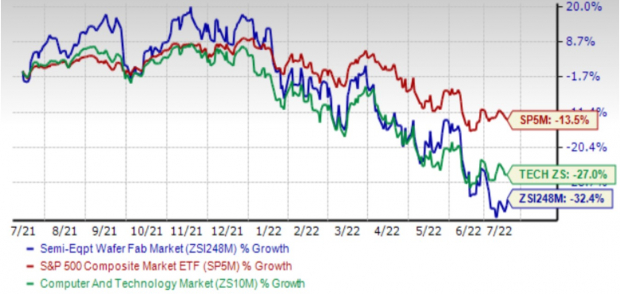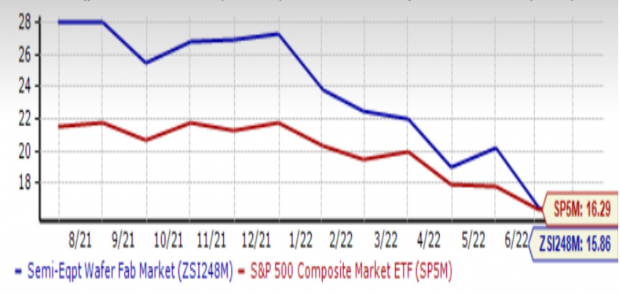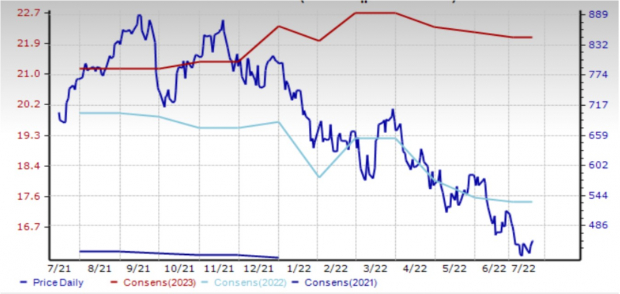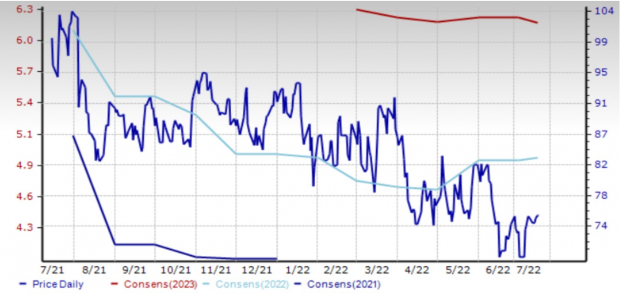The primary drivers of wafer fab equipment demand are the underlying strength of semiconductor demand and the existing capacity level.
Social distancing and the at-home economy have accelerated digitization, driving up chip demand. And digitization has become a broader trend as companies prioritize their technology investments. Developments in auto, industrial, clean energy, IoT, healthcare, online services and defense segments will ensure continued strength in semiconductor demand, thus driving equipment spending.
A number of countries are moving to onshore semiconductor production as a strategic necessity, which is a long-term positive.
Market researchers also see continued strength. Updated estimates from Gartner are not yet available and its prior estimates call for 10.7% growth in semiconductor equipment spending in 2022. Gartner expects WFE spending to come down in 2023 and 2024 as purchased equipment is digested.
SEMI recently updated its estimates for global fab equipment spending. The firm sees 8% growth in 2022 on top of the 7% growth in 2021. Foundry is expected to remain the biggest segment in 2022 with a 53% share followed by memory, which will account for 33% as 158 existing fabs increase capacity, accounting for 85% of total equipment spend. Spending will increase 6% in 2023, with foundry remaining by far the largest segment with 53% share followed by memory with 34%. There with be capacity increases at 129 existing fabs (83% of total spending). Taiwan, the biggest spender, is expected to increase investment by 52% in 2022, followed by Korea, which will increase by 7% and then China, which will reduce by 14%. Record investments are expected in Taiwan, Korea and Southeast Asia in 2023. The Americas will increase by 19% this year and 13% in the next.
Despite the underlying strength, macro and geopolitical considerations, and supply constraints are weighing on stocks like ASML Holding
ASML
and Advanced Energy Industries
AEIS
.
About The Industry
Wafer fabrication is a process during which a silicon wafer (usually 200mm or 300mm in size) is treated with successive layers of conductive and semiconductive material using stencil-like structures called reticles. After each deposition of material on the surface, the excess material is etched away and the wafer exposed to a light source to implant the design. This is the front end process. The back-end process is involved in cutting up the individual die, packaging for protection and use, attaching of electrical leads and sorting. Semiconductor demand primarily comes from cloud (where there is continued strength), ecommerce (relative softness), PCs (softening after huge sales during the pandemic), smartphones (moderating demand), IoT (strong demand), automotive and industrial (chip shortage), and artificial intelligence, HPC, communications infrastructure (5G-related strength).
Factors Shaping The Industry
- COVID has been both good and bad for the semiconductor industry, since it pushed up demand in some segments while depressing demand in others. Researchers are in agreement about the positive overall impact on WFE. The surge in semiconductor demand obviously has a direct impact on the WFE industry, and the biggest positive is that this equipment takes time to produce and sell. So the pandemic-related demand will boost equipment spending for a couple of years at least.
- The war in Ukraine is a general negative for the industry, especially those making equipment using neon and other gases the bulk of which are produced in the Ukraine and Russia. Even for those that don’t directly source a lot of their requirement from these countries, the general scarcity of supply is increasing prices of the commodity, which can result in weaker margins.
- Semiconductor demand is the primary driver of equipment purchases, although new fabs also play a big role. In fact, many new fabs are expected to come online over the next few years, which will make this a major driver in 2022 and beyond. According to SEMI, 10 new fabs will break ground in 2022, of which 7 are leading edge, together generating demand for $140 billion worth of equipment over the next few years. This is in addition to the 19 in 2021, of which leading edge (300mm) number 15. It generally takes two years from ground-breaking to equipping, so the current strength in equipment demand has a long tail. It is also worth keeping in mind that equipment demand tends to be relatively stable in times of short-term challenges because they are made with a longer-term objective. Memory typically makes up the largest part of WFE spending, but of the 29 new fabs mentioned here, 15 are meant for high-volume foundry production with 30,000 to 220,000 wspm capacity and 4 relate to memory production with 100,000 to 400,000 wspm capacity.
- China continues to play a big role (as both consumer and manufacturer of chips) because of the government’s initiative to make the country a major producer of semiconductors. While there are political pressures from across the world, particularly from the U.S., the Chinese are very determined to get there and have their own global relationships and partners. Since the west doesn’t want to sell it the most advanced equipment, it is investing heavily in its own equipment technology and there are concerns that it may have stolen some intellectual property. But because this is likely to take a few years, it’s a positive that of the 29 new fabs breaking ground in 2021 and 2022, 8 will be built in China. Because they will have to use imported equipment.
- Technology transitions, an important consideration for equipment purchases, will continue to respond to the move toward larger wafer sizes (fab upgrades to 300mm, as well as continued demand for 200mm), shrinking nodes (7nm and below), memory chip advancements (4D NAND as increasing layers are adding complexity), denser packaging (MEMS) and so forth. Materials research, device complexities, the need for greater manufacturing integration and new applications are also important factors. Other inflections will come from new chip architectures like workload-specific ASICs; next-generation 4D NAND; new materials in gate, contact and interconnect; advanced patterning; and advanced packaging. The increased complexity of building modern chips is good for equipment makers.
Zacks Industry Rank Indicates Dismal Prospects
The Zacks
Semiconductor Equipment -Wafer Fabrication
Industry is a stock group within the broader Zacks
Computer And Technology
Sector. It carries a Zacks Industry Rank #223, which places it in the bottom 11% of more than 250 Zacks industries.
Our research shows that the top 50% of the Zacks-ranked industries outperforms the bottom 50% by a factor of more than 2 to 1. So the group’s
Zacks Industry Rank
, which is basically the average of the Zacks Rank of all the member stocks, indicates relative stability going forward.
The industry’s positioning in the bottom 50% of Zacks-ranked industries is a result of the weakening in the earnings outlook of constituent companies in aggregate. The industry’s aggregate earnings estimate revision for 2022 represents a 3.7% decline from Jul 2021, while the 2023 revision amounts to a 5.6% increase.
Before we present a few stocks that you may want to consider for your portfolio, let’s take a look at the industry’s recent stock-market performance and valuation picture.
Industry Lagging On Shareholder Returns
The Zacks Semiconductor-Wafer fab Equipment Industry outperformed the S&P 500 in the last six months of last year, but has lagged the index through most of this year. It has performed similarly with respect to the broader technology sector. The main reasons for the negativity in 2022 are supply chain concerns, as exacerbated by the geopolitical crisis as well as recession fears that have impacted the whole market.
So we see that the stocks in this industry have collectively lost 32.4% over the past year, while the S&P 500 Composite lost 13.5% and the Zacks Computer and Technology Sector 27%.
One-Year Price Performance

Image Source: Zacks Investment Research
Industry’s Current Valuation
On the basis of the forward 12-month price-to-earnings (P/E) ratio, which is a commonly used method of valuing semiconductor equipment companies, we see that the industry is currently trading at 15.86X (the lowest point over the past year) and also trails the S&P 500’s 16.29X. It is also below the sector’s forward-12-month P/E of 19.48X.
Over the past year, the industry has traded as high as 28.47X, as low as 15.86X and at the median of 24.00X, as the chart below shows.
Forward 12 Month Price-to-Earnings (P/E) Ratio

Image Source: Zacks Investment Research
2 Stocks With Solid Longer-term Prospects
With pandemic concerns waning, it’s understood that the huge boost in semiconductor sales from the operating-from-home economy will not repeat, although the hybrid mode of operation has longer-term positive implications for the semiconductor and allied industries. Semiconductor demand will also be boosted by their expanding application across sectors and countries and current demand reflects this. Equipment demand is more stable than chips, because semiconductor manufacturing equipment is high-value and so, a part of the long-term planning process. That said, geopolitical tensions may disrupt the supply chain and increase cost, which will impact profitability.
The industry has however been beaten down over the last few months and is certainly worth more than its current value reflects, which could be a reason for considering these #3 (Hold) ranked stocks.
ASML Holding NV (ASML)
: This is one of the world’s largest suppliers of advanced semiconductor equipment systems consisting of lithography, metrology and inspection related systems for memory and logic chipmakers.
ASML Holding continues to see very strong demand well in excess of its available capacity. It is therefore in the process of expanding capacity and adjusting with its supply chain partners.
The Zacks Consensus Estimate for 2022 is down 0.6% in the last 30 days while the 2023 estimate is down 0.7%. Geopolitical concerns are considerable for ASML, which is making analysts incrementally cautious.
The shares are down 35.1% over the past year.
Being one of the leading players in the semi equipment space with major customers across important markets, the company is a beneficiary of strengthening demand in the industry.
Price and Consensus: ASML

Image Source: Zacks Investment Research
Advanced Energy Industries
(AEIS)
: Advanced Energy Industries is a global supplier of precision power conversion, measurement and control solutions. It is currently focused on power-conversion solutions, including direct current, pulsed DC, low frequency, high voltage, and radio frequency (RF) power supplies, as well as matching networks and remote plasma sources for reactive gas applications and RF instrumentation into the semiconductor, flat panel display and industrial markets.
Advanced Energy is seeing strong momentum across end markets, particularly for its dielectric etch, RPS and panel-level packaging products. Improving prospects in enterprise computing and 5G, as well as improving component supplies are positives.
This stock has lost 24.8% of its value over the past year. The Zacks Consensus Estimates for 2022 earnings is up 0.8% in the last 30 days. The estimate for 2023 is down 0.6%.
Price and Consensus: AEIS

Image Source: Zacks Investment Research
Zacks Names “Single Best Pick to Double”
From thousands of stocks, 5 Zacks experts each have chosen their favorite to skyrocket +100% or more in months to come. From those 5, Director of Research Sheraz Mian hand-picks one to have the most explosive upside of all.
It’s a little-known chemical company that’s up 65% over last year, yet still dirt cheap. With unrelenting demand, soaring 2022 earnings estimates, and $1.5 billion for repurchasing shares, retail investors could jump in at any time.
This company could rival or surpass other recent Zacks’ Stocks Set to Double like Boston Beer Company which shot up +143.0% in little more than 9 months and NVIDIA which boomed +175.9% in one year.
Free: See Our Top Stock and 4 Runners Up >>
Want the latest recommendations from Zacks Investment Research? Today, you can download 7 Best Stocks for the Next 30 Days.
Click to get this free report








